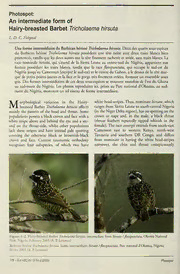
An intermediate form of Hairy-breasted Barbet Tricholaema hirsuta PDF
Preview An intermediate form of Hairy-breasted Barbet Tricholaema hirsuta
, , Photospot: An intermediate form of Hairy-breasted Barbet Tricholaema hirsuta L. D. C. Fishpool UneformeintermediaireduBarbicanherisse Tricholaemahirsuta. Deuxdes quatresous-especes du Barbican herisse Tricholaema hirsuta possedent une tete noire avec deux traits blancs bien prononces, tandis que les deux autres ont latete finement tachetee et striee, sans traits blancs. La race nominale hirsuta qui s’etend de la Sierra Leone au centre-sud du Nigeria, appartient aux , formes possedant les traits blancs, tandis que la race flavipunctata, qui occupe le sud-est du Nigeriajusqu’au Cameroun (excepte le sud-est) et le centre du Gabon, ale dessus de latete mar- que de petits points jaunes et la face et la gorge tres finement strides, formant un ensemble assez gris. Des formes intermediaires de ces deux sous-especes se trouvent toutefois de Test du Ghana au sud-ouest du Nigeria. Les photos reproduites ici, prises au Parc national d’Okomu, au sud- ouest du Nigeria, montrent un tel oiseau de forme intermediaire. M orphological variation in the Hairy- white head-stripes. Thus, nominate hirsuta which , breasted Barbet Tricholaema hirsuta affects ranges from Sierra Leone to south-central Nigeria mainly the pattern ofthe head and throat. Some (in theNigerDeltaregion), has no spottingon the populations possess a blackcrown and facewith a crown or nape and, in the male, a black throat white stripe above and behind the eye and a sec- (throat feathers reputedly tipped whitish in the ond on the throat-side, whilst other populations female). The race ansorgiiextends from south-east lack these stripes and have instead pale spotting Cameroon east to western Kenya, north-west DR covering the otherwise black or brownish-black Tanzania and southern Congo, and differs crown and face. Current taxonomic orthodoxy from nominate in having the white head-stripes recognises four subspecies, of which two have narrower, the chin and throat conspicuously Figures 1-2. Hairy-breasted Barbet Tricholaemahirsuta intermediate form hirsuta/flavipunctata, OkomuNational Park, Nigeria, February2005 (A. P. Leventis) Barbican herisse Tricholaemahirsuta forme intermediairehirsuta/flavipunctata, Parcnational d’Okomu, Nigeria, fevrier2005 (A. P. Leventis) 172-BullABCVol12No2(2005) Photospot streaked white, and yellow spotting extending ature and these photographs serve as cautionary from the back onto the nape and, sometimes, the reminders oftheir existence. It seems that there is crown. The colours of the body are also less much still to be learned ofthe status and distribu- intense; thus, it has brownish-black, rather than tion ofthe races of T. hirsuta. Indeed, it appears black, upperparts and the yellow belly is duller. that some confusion even remains over sexual Geographically interposed between them, from dimorphism in nominate hirsuta. For example, south-east Nigeria to Cameroon (except the Bates (1930) suggested that the throat of the south-east) and central Gabon, is flavipunctata, female iswhitish streaked blackwhilst in the male whichhas theface blackishwithwhitish spots and it is uniformly black. This was disputed by yellow spotting or narrow streaking covering the Bannerman (1933) who thought that both sexes forehead, crown and nape. Below, the belly of were dark-throated. This still does not seem to flavipunctata is very dull yellow with predomi- have been resolved as, in the more recent standard nantly brown, not black, markings. Lastly, works, whilst there is no mention ofa sexual dif- angolensis fromsouthern GabonandsouthCongo ference in throat colour in Borrow & Demey to north-,west Angola and southern DR Congo, (2001) or Short & Horne (1988, 2001), Short & has a brownish crown, pale streaky spots on the Horne (2002) statesuchadifferencedoesexistand face and a brownish-white throatwith darker bar- illustrate it. Further fieldworkis clearlycalled for! ring; angolensisalso differs conspicuouslyfrom the other races in being much the brownest of the References four, with little yellow on the breast and belly Bannerman, D. A. 1933. The Birds ofTropical West (Short & Horne 1988, 2001, 2002). Africa.Vol. 3. London, UK: CrownAgents. The nominate race andflavipunctata do, how- Bates, G. L. 1930. HandbookoftheBirdsofWestAfrica. ever, intergrade across a broad region extending London,&UK:John Bale, Sons & DanielssonLtd. from eastern Ghana, through Togo to south-west Borrow, N. Demey, R. 2001. BirdsofWesternAfrica. Naicgceormipaa(nSyhionrgt &phoHtoorgnraeph1s988(F,ig2s0.011-,2)2,00t2a)k.enThien ShortL,onLd.oLn.,&UKH:orCnher,iJs.toF.phMe.r H19e8l8m..Capitonidae (ba&r- Okomu National Park, south-west Nigeria, byA. bets and tinkerbirds). In Fry, C. H., Keith, S. Urban, E. K. (eds.) The Birds ofAfrica. Vol. 3. P. Leventis, are ofsuch a bird. It shows the con- London, UK: Academic Press. ospfincuoomuisnawthietehisrusputearcaisliwuemllanads mtohuestbalcahcikalgrsotruinpde Shorta,ndL.HoLn.ey&guiHdoersn.e,OxJf.oFr.d:M.Ox2f0o0r1d.UTnoiuvcearnssi,tyBaPrrebsest.s colour to the upperparts. However, the yellow Short, L. L. & Horne, J. F. M. 2002. Family spottingon thenape, centralcrown, foreheadand, Capitonidae (barbets). In del Hoyo, J., Elliott, A., in Fig. 2, faintly on the ear-coverts and below the Sargatal,J. (eds.) HandbookoftheBirdsoftheWorld. eye, as well as the whitish throatwith darkstreak- Vol. 7. Barcelona: LynxEdicions. ing, are characters more typical offlavipunctata. These intermediate forms have long been c/o BirdLife International, Wellbrook Court, Girton Road, Cambridge CB3 ONA, UK. known and, indeed, named. Their taxonomic his- toryis, however, confusedanddoes notneedto be revisited here. Suffice to say that these intergrades have largely been overlooked in more recent liter- Photospot BullABCVol12No2(2005)-173
